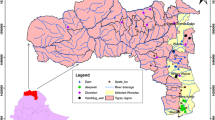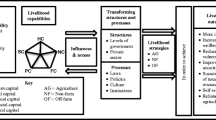Abstract
This paper aims to investigate the multifaceted factors influencing agricultural farm productivity and test the hypothesis that participation in Water Users Association (WUA) activities contributes to improved farm productivity. Primary data was collected from the Sindh and Punjab provinces of Pakistan, and hierarchical regression analysis was employed to assess the statistical significance of different variable blocks. The findings reveal that farm productivity (measured in Rs/Acre) is primarily influenced by water and land resource characteristics (54%), followed by personal characteristics of resource users (7.9%) and community and institutional characteristics (1.1%). The study identifies a negative relationship between landholding size and age with farm productivity, while a positive relationship is observed between resource users' level of participation in WUAs and farm productivity. However, it is important to note that these positive outcomes should not solely be attributed to the success of devolution of irrigation management, as inequities in canal water allocation between head and tail still persist. The paper emphasizes the critical role of participatory irrigation management governance in addressing such inequities. The results further suggest that meaningful institutional and land reforms are essential for promoting equitable economic benefits in agricultural systems.





Similar content being viewed by others
Availability of Data and Materials
Data used for the analysis of this study are available upon reasonable request.
Abbreviations
- EWP:
-
Economic Water Productivity
- WCAs/WUAs:
-
Watercourse Associations/Water Users Association
- FOs:
-
Farmers Organization
- PIM:
-
Participatory Irrigation Management
- IMT:
-
Irrigation Management Transfer
- SIDA/PIDA:
-
Sindh Irrigation and Drainage Authority/Punjab Irrigation and Drainage Authority
- LBCAWB:
-
Left Bank Canal Area Water Board
- LHS:
-
Land Holding Size
- CDI:
-
Crop Diversification Index
- TSII:
-
Technical State of Irrigation Infrastructure
- WSPI:
-
Water Scarcity Perception Index
- LPI:
-
Land Performance Index
- GDEI:
-
Group Dynamics Effectiveness Index
- CCI:
-
Community Cooperation Index
- IPAWB:
-
Institutional Performance of Area Water Board
- LPWUA:
-
Level of Participation in WUA
- WUAMI:
-
WUA Maturity Index
References
Akram AA, Mendelsohn R (2017) Agricultural water allocation efficiency in a developing country canal irrigation system. Environment and Development Economics 22(5):571–59. https://doi.org/10.1017/S1355770X17000171
Arfan M (2022b) Mapping impact of farmers organisation on the equity of water and land productivity: Evidence from Pakistan. Pak Dev Rev 61(2):275–294. https://doi.org/10.30541/v61i2pp.275-294
Arfan M (2022a) Exploring the water governance policy framework for improving participatory irrigation management reforms. Rasta: Local Research, Local Solutions 81
Assuncao JJ, Ghatak M (2003) Can unobserved heterogeneity in farmer ability explain the inverse relationship between farm size and productivity? Econ Lett 80(2):189–194
Azhar S (2016) Colonial and post-colonial origins of agrarian development: The case of two Punjabs. Dissertation, University of Massachusetts Amherst
Bandyopadhyay S, Shyamsundar P, Xie M (2010) Transferring irrigation management to farmer’s associations: Evidence from the Philippines. Water Policy 12(3):444–460. https://doi.org/10.2166/wp.2009.111
Banerjee A, Iyer L (2005) History, institutions, and economic performance: The legacy of colonial land tenure systems in India. Am Econ Rev 95(4):1190–1213
Berger T, Birner R, Mccarthy N, DíAz J, Wittmer H (2007) Capturing the complexity of water uses and water users within a multi-agent framework. Water Resour Manag 21(1):129–148
Berry RA, Cline WR (1979) Agrarian structure and productivity in developing countries: a study prepared for the International Labour Office within the framework of the World Employment Programme. Johns Hopkins
Chaudhry AM (2017) Improving on-farm water use efficiency: Role of collective action in irrigation management. Water Resour Econ. https://doi.org/10.1016/j.wre.2017.06.001
Chayanov AV (1966) The theory of peasant economy. In: Thorner D, Kerblay B, Smith REF (eds). Irwin, Homewood, Ill., USA
Cornia GA (1985) Farm size, land yields and the agricultural production function: An analysis for fifteen developing countries. World Dev 13(4):513–534
Deininger K, Squire L (1996) A new data set measuring income inequality. World Bank Econ Rev 10(3):565–591
Deolalikar AB (1981) The inverse relationship between productivity and farm size: a test using regional data from India. Am J Agr Econ 63(2):275–279
Dubois E, Blank G (2018) The echo chamber is overstated: the moderating effect of political interest and diverse media. Inf Commun Soc 21(5):729–745
Elahi E, Khalid Z, Weijun C, Zhang H (2020) The public policy of agricultural land allotment to agrarians and its impact on crop productivity in Punjab province of Pakistan. Land Use Policy 90:104324
Expósito A, Berbel J (2019) Drivers of irrigation water productivity and basin closure process: Analysis of the Guadalquivir river basin (Spain). Water Resour Manag 33(4):1439–1450
Fox J (2019) Regression diagnostics: An introduction. Sage Publications
Henderson HV, Velleman PF (1981) Building multiple regression models interactively. Biometrics 391–411
Kamara AB (2004) The impact of market access on input use and agricultural productivity: Evidence from Machakos District Kenya. Agrekon 43(2):202–216
Karaye AK et al (2017) Influence of agronomic practices on crop production. Int J Sci Basic Appl Res 31(1)
Kerlinger FN (1966) Foundations of behavioral research. New York
Lewis M (2007) Stepwise versus hierarchical regression: Pros and cons. In: Paper presented at the annual meeting of the Southwest Educational Research Association, February 7, 2007, San Antonio
Mekonnen DK, Channa H, Ringler C (2015) The impact of water users’ associations on the productivity of irrigated agriculture in Pakistani Punjab. Water Int 40(5–6). https://doi.org/10.1080/02508060.2015.1094617.
Mihaela, M, Titan E (2014) Education and innovation in the context of economies globalization. Procedia Econ Finance 15(1042–1046). https://doi.org/10.1016/S2212-5671(14)00667-4
Pedhazur EJ (1997) Multiple regression in behavioral research. Harcourt Brace, Orlando, FL
Sen AK (1962) An aspect of Indian agriculture. Econ Weekly 14(4–6):243–246
Tavakol M, Dennick R (2011) Making sense of Cronbach’s alpha. Int J Med Educ 2:53–55. https://doi.org/10.5116/ijme.4dfb.8dfd
Teeroovengadum V, Seetanah B, Bindah E, Pooloo A, Veerasawmy I (2021) Minimising perceived travel risk in the aftermath of the COVID-19 pandemic to boost travel and tourism. Tourism Rev 76(4):910–928. https://doi.org/10.1108/TR-05-2020-0195
Thapa S (2007) The relationship between farm size and productivity: Empirical evidence from the Nepalese mid-hills. Available at https://mpra.ub.uni-muenchen.de/id/eprint/7638
Wang J, Xu Z, Huang J, Rozelle S (2006) Incentives to managers or participation of farmers in China’s irrigation systems: which matters most for water savings, farmer income, and poverty? Agric Econ 34(3):315–330
Acknowledgment
We gratefully acknowledge all of the hard work of the data collection and data entry team at USPCAS-W, MUET: Hamza Sarwar, Zain, Saira Sidhu, Nabeel Ali Khan, and Mumair Chang. We thank Zunaid Alam Memon and Abdul Islam Lodhi for their input on survey tool design and sampling design and Maaz Saleem/ Sikandar Mangrio– our project’s focal person at the Nara Canal Area Water Board—for help with the recruitment of study participants. We especially thank all of the study participants for taking the time to answer so many questions and share their perspectives.
Funding
This research was supported by the ‘Research for Social Transformation & Advancement’ (RASTA), a Pakistan Institute of Development Economics (PIDE) initiative, through Competitive Grants Programme Award [Grant No. CGP-01-027/2021].
Author information
Authors and Affiliations
Contributions
Conceptualization: M. Arfan; Formal analysis: M. Arfan, A. Ullah; Writing—original draft: M. Arfan; Review and editing: K. Ansari, A. Ullah. All authors have read and agreed to the published version of the manuscript.
Corresponding author
Ethics declarations
Ethical Approval
Ethical approval for the survey instrument used was taken from the Research Advisory Committee of the US-Pakistan Center for Advanced Studies in Water Jamshoro.
Consent to Participate and Publish
All participants were briefed about the objective and purpose of the research study and written consent was taken before the data collection and to publish the research findings as well.
Competing Interest
All authors declare there is no competing interest
Additional information
Publisher's Note
Springer Nature remains neutral with regard to jurisdictional claims in published maps and institutional affiliations.
Rights and permissions
Springer Nature or its licensor (e.g. a society or other partner) holds exclusive rights to this article under a publishing agreement with the author(s) or other rightsholder(s); author self-archiving of the accepted manuscript version of this article is solely governed by the terms of such publishing agreement and applicable law.
About this article
Cite this article
Arfan, M., Ansari, K. & Ullah, A. What Socio-Technical and Institutional Determinants Explain the Farm-Level Economic Divergence?. Water Resour Manage 37, 4039–4057 (2023). https://doi.org/10.1007/s11269-023-03538-5
Received:
Accepted:
Published:
Issue Date:
DOI: https://doi.org/10.1007/s11269-023-03538-5




